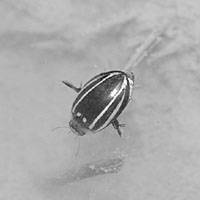* Japanese name: Shima-gengorou
* Scientific name: Hydaticus bowringii
* Description: This beetle is small, some 15 mm long, but sturdy. Its elytra (wing cases) are black, with an almost lacquered quality. What makes this species unmistakable are the two golden stripes running down the length of each elytron. There is also a golden spot on each elytron, just where the abdomen joins the thorax. The beetles have long, threadlike antennae. They swim in a highly distinctive style, kicking the back legs simultaneously, like a frog. The legs are fringed with bristles that increase the area of the leg on the downstroke, making it more paddle-like and giving more drive. The elytra are grooved in males and smooth in females.
* Where to find them: Lakes and ponds from Honshu to Kyushu, in spring. In winter, they hibernate in the mud at the bottom of them. They are most easily found in stagnant, murky ponds.
* Food: Diving beetles are known as the cleaners of the pond, as they will eat the corpses of dead animals that have sunk to the bottom. They also hunt for dragonfly nymphs and do us a favor by eating the larvae of mosquitoes. They also eat crustaceans and tadpoles. The larvae are also carnivorous and have long crescent-shaped, sharp mouth parts, which they use to stab prey items. These mandibles are hollow, and the larvae use them to suck up the body fluids of their victims.
* Special features: Diving beetles use an aqua lung. Sealed between the elytra and the abdomen is a bubble of air, which supplies the beetle's oxygen. In stagnant ponds this is often a problem -- ponds become stagnant when there is not much oxygen dissolved in the water. Diving beetles don't need to worry about this as they carry their own air supply. When they break the surface of the water they replenish their "tank." The female lays white eggs on water weeds. The eggs hatch quickly, in about a week, and there are only three stages, or instars, of larval development. After 21 days, a new adult will be ready. This means there can be three or four generations in a year. If a larva doesn't complete development before the weather becomes cold, it can simply hibernate in the mud like the adults.
PHOTO COURTESY OF BIO-IMAGE NET

















With your current subscription plan you can comment on stories. However, before writing your first comment, please create a display name in the Profile section of your subscriber account page.